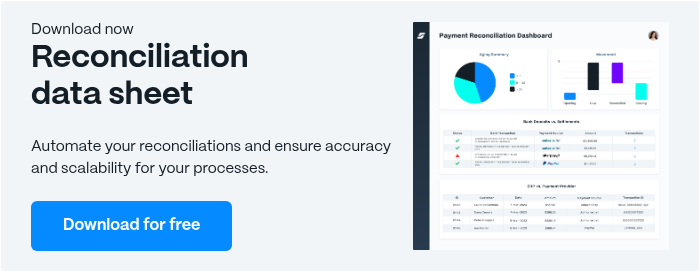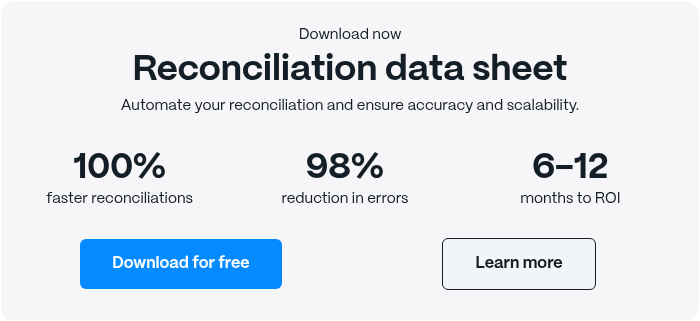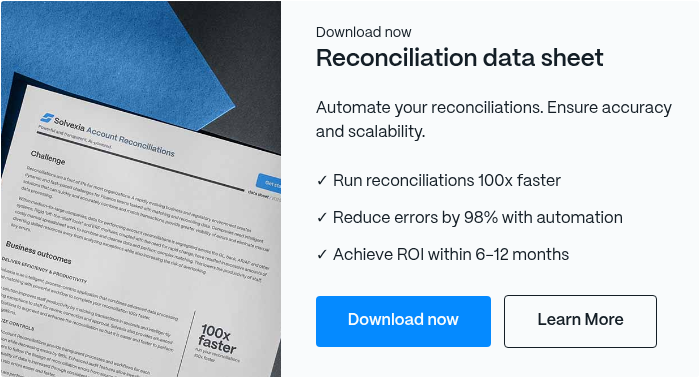Medical Billing Reconciliation Process: Expert Tips

The healthcare revenue cycle relies on the completion of the medical billing reconciliation process. When performed manually, the process is time-consuming, error-prone, and cumbersome.
However, companies can leverage finance automation software, like Solvexia, with reconciliation features to streamline their health claims reconciliation process.
We’ll cover everything you need to know in this article.
Coming Up
What is Revenue Reconciliation?
Revenue reconciliation is the process of reviewing claims, payments, and adjustments to ensure that payments are recorded properly within the provider’s own systems and paid accordingly by patients.
It consists of:
- Payment Reconciliation: Providers have to look over the recorded payments received from insurance companies, payers, and patients to make sure they are right.
- Claims Reconciliation: By reviewing claims that are submitted to insurance companies, providers can identify and rectify any discrepancies in reimbursement amounts or any denied claims.
- Adjustments: In some cases, there may exist contractual allowances or write-offs which must be recorded in the provider’s financial records.
What is Revenue Reporting?
For financial management, compliance, analysis, and decision making, revenue reporting is a critical step. This is where providers generate statements and financial reports that summarize revenues from provided services to patients.
Revenue reporting involves:
- Financial statements: Like every business knows, the most critical financial statements to regularly update are the income statement and balance sheet to retain a firm grasp on the company’s financial status.
- Compliance reporting: When it comes to the industry of healthcare, compliance and regulations are ubiquitous. As such, it may be required that providers report their revenue-generating activities to governing bodies and agencies.
- Financial analysis: With revenue reports, financial analysis can be performed to make decisions about how to boost profits and cut costs.
Medical companies are no strangers to complex sales cycles and multiple revenue streams. Finance automation software like Solvexia automates complex transactions across regulatory environments and even different currencies so that companies can remain confident in the accuracy of their financial statements and reports.
What is Medical Billing Reconciliation?
As you know, reconciliation is the process of comparing a company’s internal records with external statements and documentation to ensure that each record is in alignment and final account balances match up.
In terms of medical billing, reconciliation compares billing records to the payments that are received from insurance companies. This is performed to make sure that insurance companies are paying the right amounts.
If there is a discrepancy, it alerts the provider to investigate and remedy the account so that there will no longer be a balance remaining.
What is the Importance of Reconciliation in Medical Billing?
Between 2023 and 2024, healthcare spending in the United States is expected to grow by a total of $4.9 trillion. The astounding cost of healthcare continues to rise, and it is increasingly important for providers (and patients) to keep track of costs.
Reconciliation is how healthcare providers receive reimbursements and payments in a timely and accurate manner. This is the foundation for stable revenues, which is necessary to keep providers in business.
With a consistent medical billing reconciliation process, providers and insurance companies can maintain solid working relationships in an effort to provide value to the patients who need healthcare.
What is the Reconciliation Process in Medical Billing?
Every provider will work through the reconciliation process in their own nuanced ways, using tools of their choices and at a consistency that works for their respective business. With that being said, there are key steps to execute the medical billing reconciliation process correctly, which include:
1. Data Collection
In order to have documentation to compare, you must have documentation in hand to review. The process begins by gathering all billing information and relevant documentation. When working across offices and locations, paper-based trails are going to cause obvious delays and hardships.
When you utilize software like Solvexia, you can easily integrate your existing accounting systems and technologies to automatically centralize and pull all data in one secure and accessible location.
2. Compare Information
Now it’s time to compare information and locate any discrepancies that may exist between the company’s records and billing information. If discrepancies do arise, it’s of paramount importance to investigate why they exist.
3. Investigation and Resolution
After performing due diligence to determine why records were mismatched, the obvious next step is to resolve them. You may have to contact vendors at this stage to learn more.
4. Account Reconciliation
The crucial and primary function of reconciliation is to reconcile accounts, of course. Once you’ve figured out the reason for any mismatched records, you can update the records with the correct billing details.
As you can imagine, the higher number of transactions and claims, the more time that reconciliation will take. This is also true if you perform reconciliation infrequently and records start to pile up.
Rather than accumulating a ton of medical transactions to go through, you can automate the entire process with a finance automation tool like Solvexia.
Solvexia ensures regulatory compliance, automatically compares even the most complex transactions, reduces delays due to timing issues, helps to manage the supply chain and inventory, and optimizes revenue recognition, to name a few of its functions.
What are the Benefits of Payment Tracking for Health Care?
Reconciliation in medical billing and payment tracking are necessary for health care companies to be able to manage their finances. Payment tracking enables providers to:
1. Identify Outstanding Payment Amounts
Payment tracking makes it possible to denote outstanding amounts vs. paid amounts from both insurance companies and patients.
2. Locate Partial Payments
In some cases, invoices are only paid partially, especially by insurance companies, so with payment tracking, health care companies know if they are still owed money on invoices.
3. Improve Clinic Management
Tracking payments means that you have an understanding of your cash flow, which can help identify areas for improvement and focus to maximize revenue.
4. Reduce Issues
Should there be outstanding payments owed, timely notices can be sent to insurance companies and patients to collect.
5. Recognize Debt
It may be the case that patients and insurance companies simply won’t pay, so you can recognize bad debt when being faced with it.
How Does Reconciliation Improve Accuracy?
Without performing the medical billing reconciliation process, your business could be facing inaccuracies in its billing and, thus, receiving what it is rightfully owed.
When moving through the medical billing reconciliation process, you are able to:
- Compare billing records and insurance claims
- Notice any errors between the two records
- Identify the reasoning and take action to ensure they match up
- Resubmit claims for payment and approval
Each step is a movement in the direction of utmost accuracy. When it comes to finances, accuracy is the number one priority.
What are the Challenges of the Medical Billing Reconciliation Process?
All reconciliation processes are plagued by their own set of common challenges. When it comes to medical billing reconciliation, the process is both inherently unique and naturally complex due to regulations, policies, and the vast array of services provided.
Common challenges include:
1. Human Error
There is no denying that manual data entry is error-prone. No matter how carefully one may input records, there is always the chance for a mistake. The risk of error grows as the volume of billing data increases.
2. Complicated Policies
Insurance policies all have their own set policies, rules, and requirements. Being able to keep up with every demand is also hard to accomplish when manually keeping track and submitting claims.
3. Lack of Communication
Delays in communication between providers and insurance companies also can lead to ineffective reconciliations that are stifled by bottlenecks.
It seems like a lot to overcome, but in the next sections, we’re going to share how best practices, and more importantly, the best tools, can alleviate the burden of the medical billing reconciliation process.
What are Best Practices for Billing Reconciliation?
To streamline your medical billing reconciliation process, here are some useful and handy tips to remember and implement:
- Set Clear Processes: Start by clearly defining and designing your reconciliation process. Make sure that everyone involved knows the steps, as well as their responsibilities.
- Be Consistent: Constantly review billing information to prevent errors. The more consistently that you can reconcile your billing, the less issues you’ll have to fix at once.
- Train Staff: Everyone involved should know what their role is, as well as what steps to take should they find any discrepancies.
- Leverage Technology: We cannot overstate the importance of reconciliation software, especially for Medtech and healthcare companies. Automation solutions like Solvexia are easy-to-implement and use.
Once you use Solvexia to run your billing reconciliation, you can remain confident in knowing you have accurate financial reporting, remain compliant, reduce fraud, and can manage cash flow effectively. Request a demo to see what we mean!
What are the Best Tools for Medical Billing Reconciliation?
By implementing technology within your business to help manage your medical billing reconciliation process, everyone can take a huge sigh of relief.
These tools prove to be highly advantageous:
1. Automated Billing Reconciliation Software
Automated reconciliation software like Solvexia automatically compares the payments you receive with your medical billing records to confirm that everything is in order and no mistakes have been made.
2. Billing Management Systems
Billing management systems handle everything from claims submissions through to payment tracking, so that you can rest assured your medical billing is on track.
3. Data Analytics Tools
In order to make informed business decisions, the use of data analytics tools help to detect payment trends and even insights to improve upon the reconciliation process.
4. Electronic Remittance Advice (ERA) Systems
ERA systems make it easy for insurance companies to electronically send payment information to providers, removing manual data entry needs. As a result, payment verification can occur more quickly.
What are the Benefits of Billing Reconciliation Software?
When you utilize billing reconciliation software, your entire company will be able to notice the positive effects, including:
1. Time Savings
Manual billing reconciliation is incredibly time-consuming. With reconciliation software, the entire process is automated and streamlined, allowing your finance team to focus on high-level and value-added activities rather than manual data entry and transaction matching.
2. Cost Savings
By removing the burden of manual reconciliation, you also reduce the costs associated with it, including the cost of mistakes, as well as the added costs of extra labor.
3. Improved Accuracy
Automation software like Solvexia prevents manual errors from occurring, which can lead to inaccurate financial statements, and thus, less than optimal business decisions. With automated reconciliation, records are up-to-date and correct.
4. Boosted Efficiency
By automating the process, businesses can spend less time performing reconciliation and even speed up the time it takes to get paid.
The Bottom Line
As a healthcare finance professional, you are all too aware of the importance and need to have an accurate and timely medical billing reconciliation process.
Rather than having to suffer with manual processes, siloed data, and inaccuracies, you can make use of powerful medical billing reconciliation software with solutions like Solvexia. This way, you can ensure compliance, financial reporting accuracy, proper revenue recognition, and more.
FAQ
Intelligent reconciliation solution
Intelligent rebate management solution
Intelligent financial automation solution
Intelligent Financial Automation Solution
Intelligent financial automation solution
Intelligent financial automation solution
Intelligent financial automation solution
Intelligent financial automation solution
Intelligent regulatory reporting solution
Free up time and reduce errors
Recommended for you

Request a Demo
Book a 30-minute call to see how our intelligent software can give you more insights and control over your data and reporting.

Reconciliation Data Sheet
Download our data sheet to learn how to automate your reconciliations for increased accuracy, speed and control.

Regulatory Reporting Data Sheet
Download our data sheet to learn how you can prepare, validate and submit regulatory returns 10x faster with automation.

Financial Automation Data Sheet
Download our data sheet to learn how you can run your processes up to 100x faster and with 98% fewer errors.

Financial Automation Data Sheet
Download our data sheet to learn how you can run your processes up to 100x faster and with 98% fewer errors.

Financial Automation Data Sheet
Download our data sheet to learn how you can run your processes up to 100x faster and with 98% fewer errors.

Financial Automation Data Sheet
Download our data sheet to learn how you can run your processes up to 100x faster and with 98% fewer errors.

Financial Automation Data Sheet
Download our data sheet to learn how you can run your processes up to 100x faster and with 98% fewer errors.

Financial Automation Data Sheet
Download our data sheet to learn how you can run your processes up to 100x faster and with 98% fewer errors.

Rebate Management Data Sheet
Download our data sheet to learn how you can manage complex vendor and customer rebates and commission reporting at scale.

Top 10 Automation Challenges for CFOs
Learn how you can avoid and overcome the biggest challenges facing CFOs who want to automate.
.svg)








